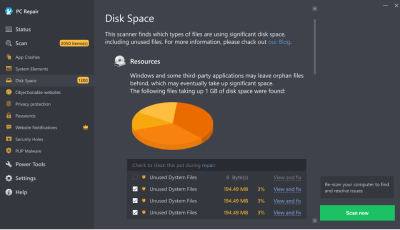How to speed up a slow Windows 10 PC
The following steps may repair the issue:
- Step 1. Download Outbyte PC Repair application See more information about Outbyte uninstall instructions EULA Privacy Policy.
- Step 2.Install and launch the application
- Step 3.Click the Scan Now button to detect issues and abnormalities
- Step 4.Click the Repair All button to fix the issues
| Compatibility | Win 11, 10, 8, 7 |
| Download Size | 21.2 MB |
| Requirements | 300 MHz Processor, 256 MB RAM, 50 MB HDD |
Limitations: trial version offers an unlimited number of scans, backups and restores for free. Registration for the full version starts from USD 29.95.

Outbyte PC Repair (version 1.1.12.641) is certified by AppEsteem – a trusted cybersecurity organization – with ongoing monitoring.
Being able to meet all of AppEsteem’s strict requirements means that Outbyte PC Repair can be considered clean, safe, and transparent; and that it is compliant with the ethical and legal norms of distribution.
AppEsteem is one of the world’s most prominent cybersecurity organizations that contributes to the safety of more than 2 billion users. The company was founded by a team of experienced Microsoft cybersecurity specialists. Its mission is to create a safe space for computer and internet users where they are protected against cyber threats and deceptive or unethical practices.
Although Windows 10 is considered to be a major improvement over the preceding Windows 8, it is prone to various performance issues, including slowdowns, which may start as early as only a couple of months after installation. Slow Windows 10 operation is the reason many users are not happy with the upgrade and search for ways to return to earlier Windows versions. Windows 10 slowdown may be caused by a wide range of factors, including file system fragmentation, broken or outdated entries in system elements, incorrect system settings that interfere with proper operation, misconfigured internet connection settings that lead to slower connection speeds and a number of other factors.
An effective way to deal with slow Windows 10 operation and to speed up PC is with the help of a special software that detects and eliminates common causes of Windows slowdowns.
The article provides details on the symptoms and causes of slow Windows 10 operation and ways to speed up PC.
Contents
[hide]Symptoms of slow Windows 10 operation
The most common symptoms of Windows 10 slowdown include increased time for startup and shutdown, slower application launching, application or whole system freezes, slower response times (which may be noticed by users of text editors, where typed characters may appear on the screen with a brief delay), application crashes that require program restarts or computer reboots. In the case of slow internet connection speed, the user may notice slower web browsing, lower file download or upload speeds, poor quality of web calls, delays in message delivery when using chat programs and a number of other slowness symptoms.
Causes of slow Windows 10 operation
Among the most common causes of slow Windows 10 operation are misconfigured system settings that require adjusting, heavy file fragmentation due to hard drives not being defragmented on a regular basis, presence of invalid or corrupt entries in system elements that prevents applications or system components from operating properly. Slow web browsing, downloads and web call interruptions on a supposedly high-speed connection are usually caused by incorrect network settings.
Ways to speed up Windows 10
Advanced PC users may be able to improve their Windows 10 computer’s speed by manually resolving common slowdown causes – by running defragmentation, adjusting system and internet connection settings, removing invalid keys from system elements. However, since any manipulations with system settings and system elements carry a risk of rendering the operating system unbootable, whenever a user is in any doubt of their technical skills or knowledge, they may use a special software that is meant to resolve common speed issues and repair system elements without requiring any special skills.
The following steps may speed up a Windows 10 PC:
- Download the PC speedup application
- Install and launch the application
- Click the Scan Now button to detect speed-reducing issues
- Click the Repair All button to speed up PC
The same application can be used to run preventative measures to reduce the chance of this or other system issues appearing in the future.




